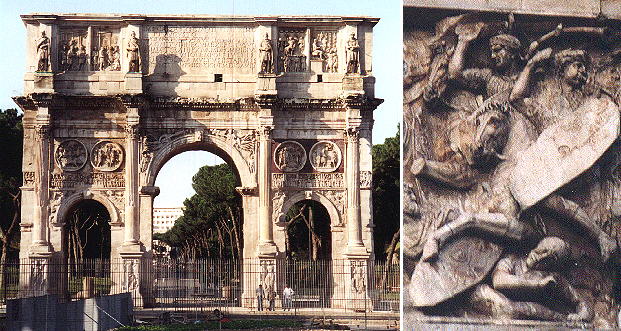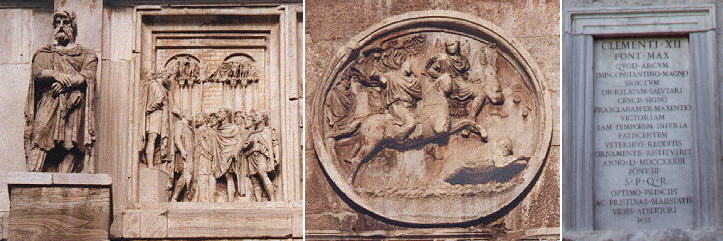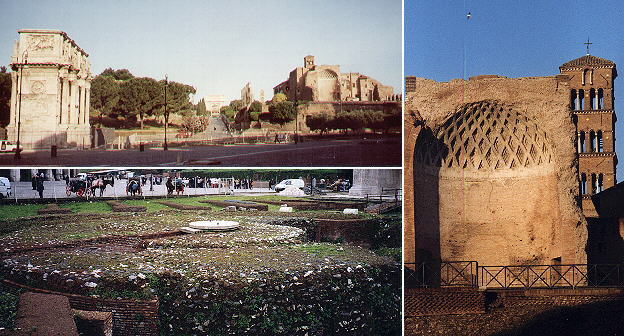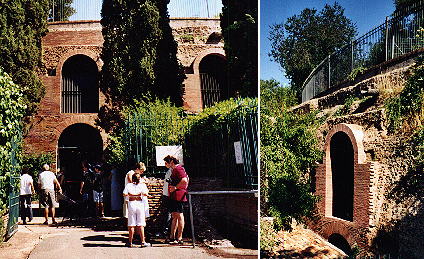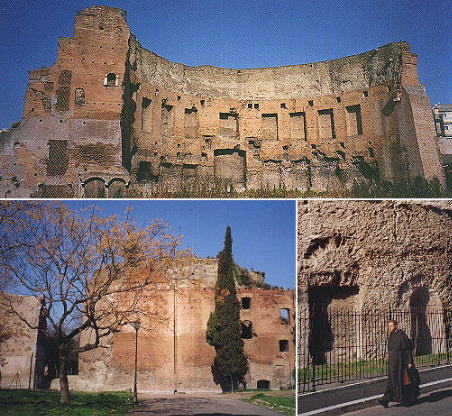  Piazza del Colosseo (Book 2) (Map B3) (Day 1) (View C9) (Rione Campitelli) and (Rione Monti) In this page:
The Arch of Constantine was most likely built for a previous emperor
of the IIIrd century. It was renovated and dedicated to Constantine to
celebrate his visit to Rome in 315. Its decoration is mainly a reassembling
of reliefs celebrating events related to Trajan, Adrian and Marcus Aurelius.
The war scene shown above is associated with the emperor Trajan. The image below shows: (left to right)
statue of a Dacian prisoner (Trajan's time); a relief showing a scene of military life
(Marcus Aurelius' time); a relief showing a hunting scene (Adrian's time). A major restoration
was conducted under Clemens XII in 1733, which included the re-integration of statues and columns.
In a few cases the statues of the emperors, which all had been turned into statues of Constantine at the time of
the dedication of the arch by changing their heads, got back the head of the
original owner.
Tempio di Venere e Romolo and Meta Sudante
The plate shows to the right of the Arch of Constantine what was left of Meta Sudans, a Roman fountain. In 1936 the ruin was still there, but it was pulled down to allow the army parade to go through the Arch of Constantine. The plate shows also to the far right the ruins of the Temple of Venus and Romulus. The statue of the god was in the niche, the decoration of which inspired many artists (see Francesco Salvi's niche in Fontana di Trevi). The photos above show also the Arch of Titus and the bell tower of S. Francesca Romana.
After one of the most damaging fires (64 A.D.) ever occurred in Rome, the Emperor Nero rebuilt on the
Palatine the Imperial Palace. The Emperor was suspected of having set fire to Rome to enlarge the Imperial Palace, which actually was expanded
by him also on the first
slopes of the Esquiline, the area to the north of the
Colosseum, (at the time the area of the Colosseum was the site of a small lake which provided the
Emperor with a nice view). Nero built a large pavilion overlooking the lake; the building was known as Domus Aurea (Golden House)
and it survived its landlord, because after the death of Nero it was used as a warehouse. In 111 A.D. Apollodorus of Damascus, the architect
of the Forum of Trajan, filled Domus Aurea with the material resulting
from the excavation of Velia a hill between the Quirinal and the Capitol which was levelled to the ground to make room for the Forum.
Apollodorus reinforced the walls of Domus Aurea and used them as foundations for the baths he built for Trajan. Domus Aurea was discovered and "excavated"
in Renaissance times and here was found the group of Laocoon and his two sons. The site
was visited by many artists, mainly painters, who found inspiration
in the decoration of the rooms (grottesque after Italian grotta,
as the entrance to these rooms looked like the entrance of a cave=grotta).
Excavations are still going on and new rooms and paintings were recently
found.
Excerpts from Giuseppe Vasi 1761 Itinerary related to this page:
Next plate in Book 2: Piazza
di S. Giovanni in Laterano
Go
to |
